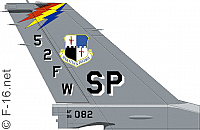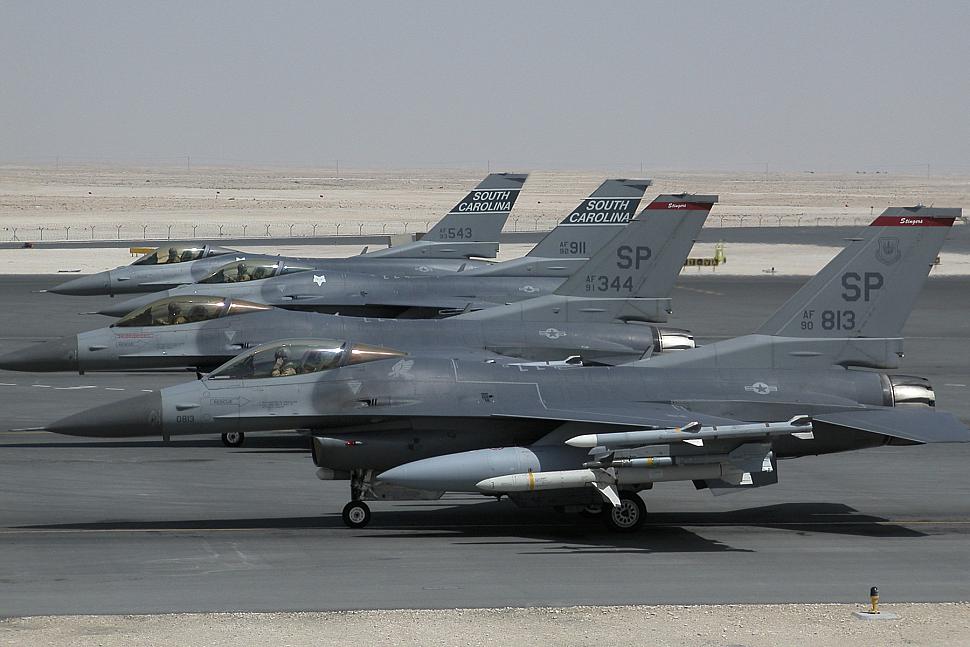 |
United States of AmericaUnited States Air Forces in Europe - USAFE |
Introduction
The USAFE was the first command after the ACC that received the F-16 to beef up the defenses against the Warsaw Pact. It was the largest F-16 contingent outside the US. After the Cold War, forces reductions only left 2 bases operational with the F-16, being Spangdahlem and Aviano.Inventory
USAFE Inventory
Shortly after the U.S. Air Force began equipping PACAF units with the F-16, European units started receiving the new Fighting Falcons as well. The first USAFE unit, the 50th TFW at Hahn AB in Germany, replaced its F-4E Phantoms with F-16 block 15 aircraft in July 1982. The 50th TFW's 313rd Tactical Fighter Squadron achieved Initial Operational Capability in December 1982, soon followed by the 496th and 10th TFS. The 86th TFW at Ramstein AB and the 52nd TFW at Spangdahlem AB, both in Germany as well, were next. On USAFE's southern flank, the 401st TFW at Torrejon in Spain began to receive Block 15 F-16s in 1983.
The F-16C was first delivered to USAFE in the mid-eighties. The 86th TFW converted to the block 30 F-16C/D in December 1985. With the introduction of the advanced F-16C/D models, the F-16 gradually replaced the F-4E in the ground attack role. The 52nd TFW used F-16s in combination with F-4Gs in the Wild Weasel Role, operating as hunter/killer pairs. The introduction of LANTIRN-capable aircraft allowed USAFE to commence night operations.
After the end of the Cold War, the European units saw drastic cutbacks. Of all USAF commands, USAFE was the one that was hit hardest by force reductions. The cutbacks started in 1991 after operation Desert Storm. At that time most units were being converted from the earlier F-16C/D models to the more advanced F-16C/D block 40/50 models. For example, Hahn AB received its new block 40 F-16s when the word to close down arrived. A year later, all activity at the base came to a halt. In total, the USAFE lost three of its five active units, only keeping the 31st Wing at Aviano (which was actually a re-activation of the deactivated 401st TFW) and the 52nd FW at Spangdahlem.
Modifications & Armament
Sure Strike
In 1995, 38 F-16C/D Block 40 aircraft of USAFE's 31st Fighter Wing based at Aviano AB, Italy, were equipped with Sure Strike. This package consists of Night Vision Goggles (NVG) and an Improved Data Modem (IDM), giving the aircraft quick reaction capability for CAS missions over Bosnia. The IDM (now standard on the Block 50/52 and MLU aircraft) allows the aircraft to receive latitude, longitude and elevation of a target direct from a FAC (Forward Air Controller) on the ground. The system then inputs the data into the weapon system computer and displays it as a waypoint on the HUD. Made up entirely from off-the shelf components, it took just 13 weeks to field Sure Strike. Due to the success of the program, the USAF decided to include Sure Strike software in the major Block 40 tape five software upgrade for the close air support update in June 1998.
Common Configuration Implementation Program
The USAFE units are equipped with the latest block 40/42 and 50/52 aircraft. These aircraft will be upgraded with the CCIP (Common Configuration Implementation Program) enhancement, just like their stateside counterparts. This modification incorporates a number of systems designed originally for the European MLU program into the existing fleet of USAF Block 40/42/50/52 aircraft. This program started in 1998. The CCIP configuration includes the following systems: Modular Mission Computer, Color Multifunction Display Set, Common Data Entry Electronics Unit, Electronic Horizontal Situation Indicator, Joint Helmet Mounted Cueing System (JHMCS), Link 16 Multifunction Information Distribution System (MIDS) and Low Volume Terminal with TACAN. This modification will allow cost savings through a common type certification and stock savings. This will greatly enhance the fleet's flexibility.

Operational Service
Units
Please refer to the F-16 Units section for an overview of units.Deployments
USAFE F-16s participated in nearly every major USAF combat deployment, except for Operation Noble Eagle. Combat deployments that USAFE F-16s did participate in: Desert Storm, Desert Shield, Operation Southern Watch, Operation Northern Watch, and Operation Iraqi Freedom.
Please use this form to add any list any error or omissions you find in the above text.
Note: your comments will be displayed immediately on this page. If you wish to send a private comment to the webmasters, please use the Contact Us link.

